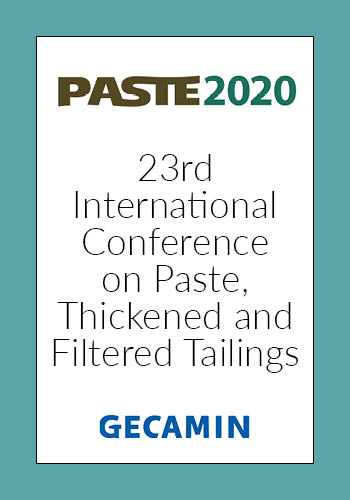Comparison between Linear and Central Distribution System for Thickened Tailings Stacking

|
Authors: Pirouz, B; Javadi, S; Seddon, K |
DOI https://doi.org/10.36487/ACG_repo/2052_25
Cite As:
Pirouz, B, Javadi, S & Seddon, K 2020, 'Comparison between Linear and Central Distribution System for Thickened Tailings Stacking ', in H Quelopana (ed.), Paste 2020: 23rd International Conference on Paste, Thickened and Filtered Tailings, Gecamin Publications, Santiago, https://doi.org/10.36487/ACG_repo/2052_25
Abstract:
One of the key parameters in successful implementation of thickened tailings schemes for tailings management is the achievable tailings beach slope. Study of geomorphology and hydrodynamics of tailings beaches has shown that the achievable beach slope is directly proportional to tailings solids concentration (i.e. rheology) and inversely proportional to discharge flowrate. Splitting the total tailings flowrate from the process plant, into multiple spigots prior to discharge to a Tailings Storage Facility (TSF), will result in formation of a steeper beach profile which will increase the storage capacity. Additionally, uniform distribution and discharge of tailings into the TSF is a key element in filling the storage evenly and optimising the TSF effective storage capacity. Two different generic spigot arrangement systems are usually used in practice for flow splitting: Linear Discharge System (LDS) and Central Discharge System (CDS). The main components and pros and cons of each system are discussed and compared in this paper. Items covered include hydraulics, operational challenges and effectiveness in flow splitting, minimising flows merging on the beach to achieve a uniform deposition and steeper beach slope, and the overall costs of the tailings management system (including tailings transport, distribution system and embankment construction). There are many aspects to be considered, but overall it is concluded that in the cases for which that the comparison has been undertaken, the CDS is a more effective, easier to operate and a less costly design than the LDS.
References:
Martinson, R. (2017) ‘Designing tailings spigot discharge system to maximise beach slope’, Paste Tailings Management-An International Mining Supplement, p. 7.
McPhail, G.I. (2015) ‘Simulation of Meandering flow path of a beaching slurry using a random walk’, Proceedings of the 18th International Seminar on Paste and Thickened Tailings (Paste 2015), Cairns, Australia, pp. 467-476.
Pirouz, B., Javadi, S., Seddon, K.D., Williams, M.P.A. (2014) ‘Modified beach slope prediction model for non-segregating tailings’, Proceedings of the 17th International Seminar on Paste and Thickened Tailings (Paste 2014), Vancouver, Canada, pp. 31-45.
Pirouz, B., Javadi, S., Seddon, K.D. (2017) ‘Thickener performance variability: underflow solids concentration and flowrate’, Proceedings 20th International Seminar on Paste and Thickened Tailings (Paste 2017), Beijing, China, pp. 10-11.
Seddon, K.D., Pirouz, B. Javadi, S. (2018) ‘Stochastic modelling of beach profile including the influence of thickener performance’, Proceedings 21st International Seminar on Paste and Thickened Tailings (Paste 2018), Perth, Australia, pp. 251-260.
Williams, M.P.A. (2014) ‘Channel hydraulics or deposition flume testing – which is right for beach slope forecasting”, Proceedings 17th International Seminar on Paste and Thickened Tailings Paste 2014), Vancouver, Canada, pp. 3–18.
© Copyright 2025, Australian Centre for Geomechanics (ACG), The University of Western Australia. All rights reserved.
View copyright/legal information
Please direct any queries or error reports to repository-acg@uwa.edu.au
View copyright/legal information
Please direct any queries or error reports to repository-acg@uwa.edu.au